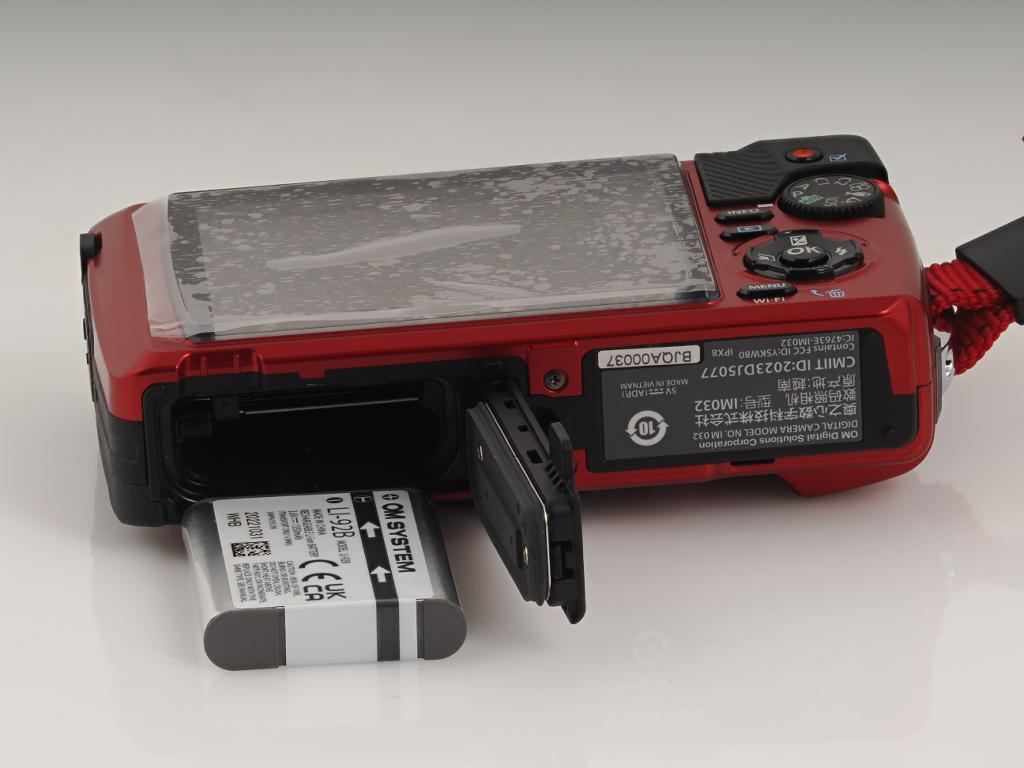
Mr Rymann announced it at a LiveTalk a few months ago: they are now working with a Dutch company that will convert the TG-7 and make it suitable for special areas. Three weeks ago I asked OMDS what the status was and was told that they had no information yet.
Now the new camera has been presented: Armadex has put a sticker on the front of the TG-7 and made sure that the flash doesn’t trigger accidentally, renamed it EX-M OZC 3 and the camera now costs 1698 euros
In 2022, they had already labelled the Ricoh G900, which was launched in 2019, with two stickers above the “Ricoh” and the “G900” and also charged a discreet premium of just under 80%. The thing was called EX-M OZC 2 at the time and also cost 1698.
If you can still remember the presentation of the TG-7: the corresponding images have been copied 1:1 to the Armadex site. If you also want to see a fully professional camera presentation of a “rugged camera” for potentially explosive environments, take a look at the video embedded on the website. My dishwasher video from 2011 can’t compete with that.
But at least I charged the camera battery and inserted a memory card before I started shooting.
I don’t know how much stickers cost and disconnecting the flash is certainly extremely time-consuming. But for a hefty 1253.46 euros extra, perhaps they could have put more effort into the video.
Oh yes: the camera is supplied in a specially designed bag. And the “country of origin” is the Netherlands. Customers are sure to be delighted when they see “Made in Vietnam” on the bottom of the camera….
But B2B is a different world anyway…. Incidentally, the prices quoted do not include VAT. There is still the 19% on top…. (Just in case someone has deducted 529 euros from 1698 and not come up with 1253.46. These are the net prices….)
By the way, Armadex is in the same building as Exmachinery and they even have the same phone number and the same boss. And ExMachinery still have the old Atex camera (the re-labelled Ricoh) on their website. They use the same photos of the zoom as the site for the TG7. So the photos there are probably not from the TG-7, but from the Ricoh.
Armadex also has a second address in Aberdeen – 7 Albert Street. A tiny detached house with four company signs on the front. It’s certainly practical.
Incidentally, the boss of Armadex and ExMachinery is an active footballer at IFC Ambacht and also sponsors the club, as well as supporting the Ridderkerk Rowdies baseball club. EXMachinery is a family business where parents and sons work. Just because the impression to the outside world is suboptimal doesn’t mean that they do a bad job. The company has been around for over two decades – and yes, of course the prices are steep – but the quantities are probably small and the insurance premiums high.
What I find exciting is that OMDS obviously also works with small, European family businesses. That’s something.
(Danke an Helmi für den Hinweis.)
Der geringfügige Aufpreis kommt evtl. durch den mitgelieferten(?) Plastikkoffer zustande? 😉
So ein Pelicase ist schon was amtliches.
Da ist ja eine OM 1.2 fast ein Schnäppchen, wenn man im Schrank ein mft-Objektiv liegen hat!
Hallo,
die ATEX-Zertifizierung ist bestimmt nicht billig. Sollte man berücksichtigen. Deshalb auch den Blitz lahm gelegt.
Heißt aber auch im Umkehrschluss, Olympus/OMDS haben irgendwas richtig gemacht. Sonst käme die Ausgangskamera dafür gar nicht in Frage.
Mich würde nur interessieren, ob die Firmware bzgl. Exifs auch angepasst wurden. Da müssten die Zertifikate auch darin abgebildet werden…?
Schönen Gruß
Das Problem ist nicht, dass die TG-7 eine schlechte Kamera ist. Beileibe nicht. Das Problem ist, dass sie im Wesentlichen eine sieben Jahre alte Kamera mit Firmwareupdate und ner neuen Lackierung ist. Für einen absurden Preis. Sie hätten auch einfach die TG-5 weiterproduzieren und durch Firmwareupdates und Sonderlackierungen pflegen können. Wäre nachhaltig und ehrlich gewesen.
Dass die Firma hier knapp 2000 Ocken für ne Knipse verlangt, die bei der Herstellung unter 100 Dollar kostet sehe ich nicht als Problem. Du sprichst es ja an: Zertifizierung, Stückzahlen. Das kostet. Die Werbung ist maximal ungeschickt weil copy and paste, aber auch das macht ja die Kamera nicht schlechter. Wenn das Marketing über die Qualität meiner Kamera entscheiden würde, wäre ich längst bei Fuji oder zumindest bei Panasonic.
Hallo,
Die Kamera ist lt. Homepage “ATEX Camera Certified For Zone 2” zugelassen. das ist die simple Form von Explosionsschutz. Daneben gibt es die Zone 1 und Zone 0.
Zone 2 heißt: explosionsgefährliche Atmosphäre tritt im Normalbetrieb nicht oder kurzzeitig auf
Zone 1: Eine explosionsgefährliche Atmosphäre tritt im Normalbetrieb gelegentlich auf.
Zone 0: Eine explosionsgefährliche Atmosphäre tritt ständig, über lange Zeiträume oder häufig auf.
Die ATEX Zetifizierung kostet in der Tat richtig Geld. Geregelt ist das in Eu-Richtlinien und der Betriebssicherheitsverordnung.
Ob sich das Geld lohnt, muss jeder für sich entscheiden.
Beim Preis kommt noch dazu, dass ATEX einen einfach zur Verwendung von zertifizierten Geräten zwingt. Nix mit einem normalen Smartfon*. Ich weiss nicht wieviele Konkurrenten die haben, nehme an wenige…
Viele Endkunden sind ausserdem in der Pharma und Chemie zu Hause. Da sind Preise sekundär.
Und als Vergleich: Ein guter, Ex zertifizierter Sensor (Druck, Temperatur etc) kostet gerne mal 5000Euro.
*)Die Aussage nix mit Smartfon musste ich nach kurzer Recherche anpassen . Inzwischen gibts die Dinger, auch mit Kamera. Bin offensichtlich schon zu lange nicht mehr in den entsprechenden Industriezweigen unterwegs.
Ich hatte mal eine ernsthaft ex-geschützte Kamera in der Hand. Ein Kunststoffgehäuse mit Überdruck drin, Akku getrennt und komplette Abschaltung bei Druckabfall. Da hat alleine das Ding rund um die eigentliche Kamera ein paar Tausender gekostet. War für den Einsatz in Bergwerken konzipiert. Dagegen ist eine gepimpte Tough ein Spaziergang. Macht in Kleinserie aber doch jede Menge an Arbeit und kostet daher auch was.